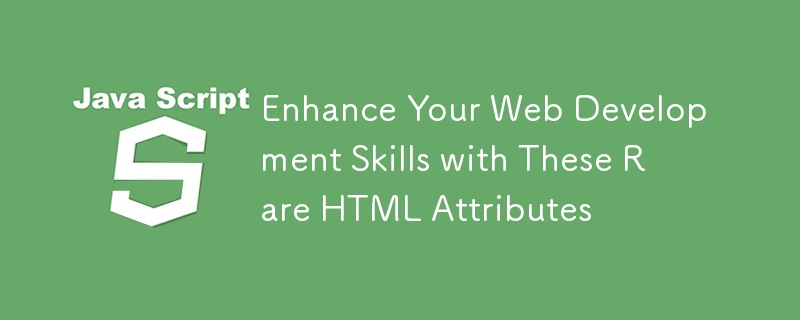

HTML attributes are most often referred to as the overlooked heroes of web development, playing a crucial role in shaping the structure, functionality, and user experience of web pages.
These modest yet powerful modifications to HTML elements can:
Help in enhancing user experience
Improve search engine optimization by providing context and meaning to search engines.
Increase web page performance by optimizing image loading and website responsiveness.
Easy interaction with JavaScript by simplifying how simple data can be stored and also trigger events
By using the power of HTML attributes, developers can develop more robust, user-friendly, and efficient web applications.
In this article, we will explore some powerful and less-known HTML attributes with their use cases, thereby unlocking new possibilities in your web application project.
Let’s dive into some of these attributes I found and think will be very helpful to us as programmers.
Definition:the download attribute used with 'a' tag, prompt a file to be downloaded rather than being opened when the link is clicked. The file must have the correct type of extension e.g .jpg, .pdf, .txt
Use case:it is commonly used when developing educational website, file sharing system and e-commerce website that offer reports or invoices to be downloaded
Benefit:
Code Example:
Download Annual Report
Definition:the hidden attribute hides an element from a webpage without deleting it from the DOM (Document object model).
Use case:used in interactive application where content visibility changes dynamically, like hiding sensitive information until needed.
Benefit:
Code Example:
This content is hidden by default
Definition: this attribute enables elements to be draged and dropped on a webpage
Use case:useful in drag and drop interface, customisable dashboard,and file uploads area
Benefits:
Code Example:
Drag me around!
Definition:it specifies whether the content in an element should be translated by the browser translation feature from its default language or not.
Use case:Useful in a website that enables multi-languages, where certain text like brand name or technical terms should not be translated.
Benefits:
Starkenny Bags - Quality You Can Trust
Definition:controls whether the browser should check spelling and grammar of text within an input field, textarea, or editable element using a boolean value true or false.
Use case:frequently used in text editors, input fields, and textarea where accuracy is required.
Benefits:
Code Example:
Definition:This attribute provides a hint to the browsers on what kind of virtual keyboard to display either numeric or alpha-numeric, optimizing input for the type of data expected.
Use case:commonly used in mobile banking apps, where numeric or specialized inputs are needed.
Benefits:
Code Example:
Definition:controls text capitalization in input field, textarea, and editable content
Use case:used in messaging app, form input field that benefits from automatic text formatting like capitalizing names or starting sentence with uppercase letters
Benefits:
Code Example:
Definition:the min and max attribute are used with the element to specify the minimum and maximum values users can input in a field. They are commonly used with types like numbers, date, range, time.
Use case:
Form validation to make sure user input the correct value and the value is between the range specified by the programmer
Restrict values in sliders to specific range, such as selecting temperatures brightness levels, or rating
Benefits:
Code Example:
New notification received.
Click here to learn more about the aria attribute
Definition:the data attribute allow developer to store custom data inside html element without affecting the page appearance and it is also used to pass data from the html page to javascript. The attribute state with data-, followed by a custom name (any name you want)
Use case:
Passing data from html to javascript
Storing user preferences
Tracking and analysis
Benefits:
Code example:
Product Name
**Definition: **this attribute can be added to an html element to enable user to edit content inside the tag ot not . it uses boolean data type to true or false when set to true the content will be editable, and false the content will be locked
Use case:
Benefits:
Code Example:
This is an editable div. You can change this text by typing here.
In this article, we explored several lesser-known HTML attributes that can significantly enhance the functionality, accessibility, and user experience of your web applications. We covered:
Now that you’re familiar with these powerful attributes, why not try incorporating them into your next project? Test how min and max can simplify input validation, use aria attributes to make your applications more inclusive, and leverage data attributes to streamline your JavaScript code. Share your experiences, and let us know how these attributes have improved your workflow or enhanced your projects! Your journey into mastering these hidden gems of HTML is just beginning—let’s continue to explore and innovate together!
The above is the detailed content of Enhance Your Web Development Skills with These Rare HTML Attributes. For more information, please follow other related articles on the PHP Chinese website!
 How to open db file
How to open db file How to remove Firefox security lock
How to remove Firefox security lock There is an extra blank page in Word and I cannot delete it.
There is an extra blank page in Word and I cannot delete it. what python can do
what python can do The difference between threads and processes
The difference between threads and processes How to generate bin file using mdk
How to generate bin file using mdk How to solve the problem of not being able to create a new folder in Win7
How to solve the problem of not being able to create a new folder in Win7 Usage of boolean in java
Usage of boolean in java



